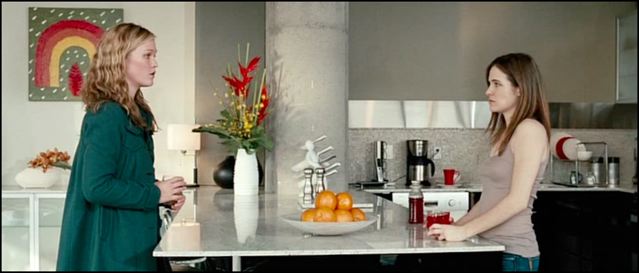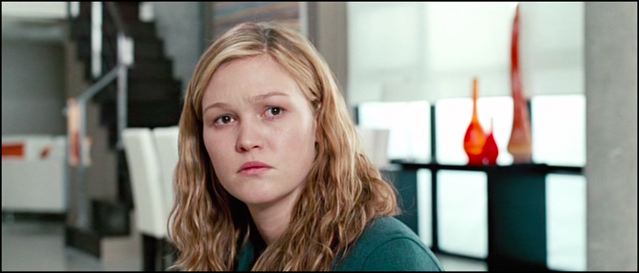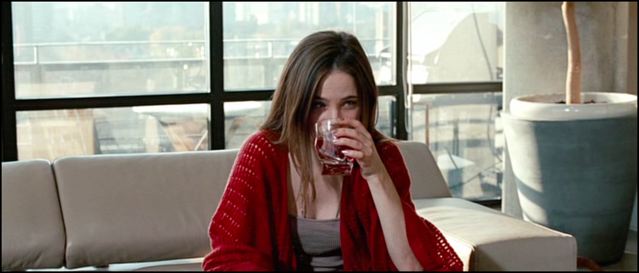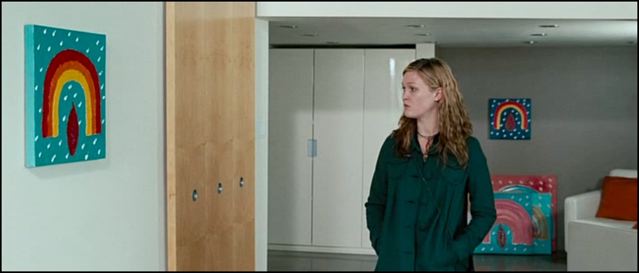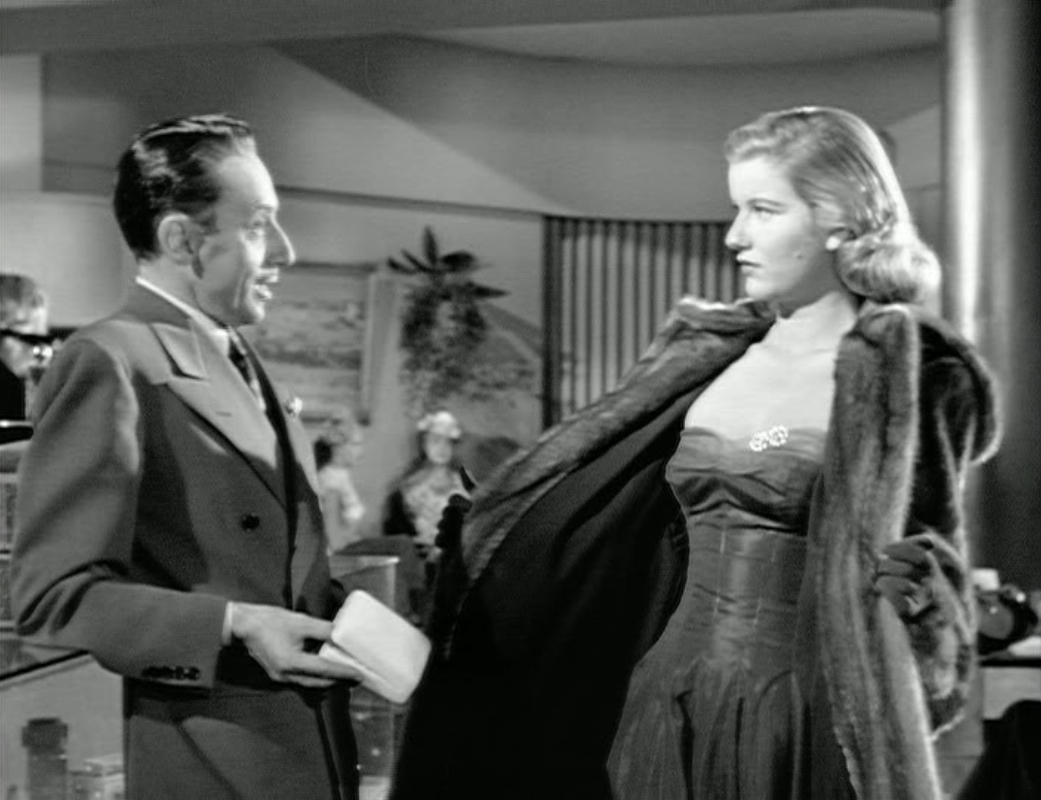John Gibbs
Close Reading: The Cry of the Owl (2009) [1]
and Interview
In Patricia Highsmith’s novel (1962), from which the film is adapted, Nickie, the ex-wife of the central character Robert Forester, is unremittingly awful. Writer/director Jamie Thraves described the character as written as being ‘really over the top, really screechy’, in a Q&A at the Raindance Film Festival. At the same time, she is too central to the story to be simply excised in an adaptation. A small scene in the later stages of the film, which does not have a direct equivalent in the book, indicates some of the film’s solutions to this problem.
Jenny (Julia Stiles), has traveled from her small town to the city to visit Nickie (Caroline Dhavernas); Jenny is involved with Robert (Paddy Considine), who is under suspicion in the disappearance of Jenny’s former boyfriend. After introducing themselves warily, and with amused hostility in Nickie’s case, the conversation turns rapidly to Robert.
Nickie maintains that she doesn’t hate Robert, but that she has come to realize that ‘some people are poison for you in this life. It’s not always clear who they are, but, when you find out who it is, you have to cut them out.’ On the pause before the words ‘when you find out who it is’, the film cuts from a shot of Nickie speaking to one of Jenny listening. The camera tracks right and slowly in to Jenny’s head and shoulders as she listens intently, mouth defensive, brow slightly creased, eyes fixed beyond the camera in the direction of Nickie, the shot concluding with a moment’s stillness in the silence after Nickie has ceased to speak.
Both Julia Stiles’ performance and the camera movement — Alex Clayton has pointed out that this kind of edging in to a character, coupled with a mediative offscreen gaze, is a familiar convention for indicating a character in serious reflection — suggest that these words find fertile ground in Jenny’s heart, receptive as we know her to be to notions of fate and predetermination, and understandably unnerved by recent events.[2]
However, rather than finish here — withdrawing from the scene with the emphasis on the impact of these ideas on Jenny — the film cuts back to Nickie. She reaches deliberately for her drink, dropping her gaze as she does so, before looking briefly back toward Jenny. She then looks away, an upward glance playing quickly across her features, perhaps a smirk concealed behind her glass, before looking swiftly but sharply in the direction of Jenny once again, as she presses her lips together in a half smile. She puts the glass back on the table, looks away, and the sequence ends.
This extra shot, beyond the obvious requirements of the scene, balances our sense of the impact of Nickie’s words on Jenny with another opportunity to observe Nickie herself. These glances and expressions — almost playful, certainly wry — contrast with her deadpan reflection on the hard-won life lesson of a moment before. Her expressions are much more like the openly mischievous glances of earlier in the scene, though now they involve an attempt to veil her amusement. But they also — the last look in particular — suggest that Nickie is interested to see what effect her words are having, and is not experienced or confident enough to be sure without stealing a glance.
This makes it possible to apprehend Nickie’s lack of sincerity in relation to the sentiments she has voiced, presenting her nuisance-making in ways which suggest naivety and childishness, and indicating that she is not entirely comfortable in the role she has cast herself. (Her discomfort is also registered in the way she pulls the cardigan around her vest top on sitting down.) Just as importantly, the extra shot invites us to reflect skeptically on Jenny’s susceptibility to portentous rhetoric; rather than take Jenny’s emotional response as a conclusion, a more complex view is provided as Jenny’s feelings are counterpointed by a perspective which asks us to question whether she should be so credible. The film is clear-eyed here, inviting us to consider the exchange with a sharper perception than seems available to either Jenny or Nickie themselves.
There are also some observations to be made about how the wider scene presents Nickie in terms of setting. The flat aspires to modern urban chic, full of clean lines and bold decorative glassware, indicating a very different environment to the one in which Jenny chooses to live. We might also notice the paintings on the wall, as Jenny does, dominated by the repeated motif, in different colors of a rainbow as if drawn by a child, and the stack of further variations on this theme leaning against the wall behind Jenny as she comes in.
This helps to provide a further context for Nickie, though one that has to be gleaned from these details: aspiring painter, whose optimistic imagery hasn’t been matched by success. Together with the humor and vivacity that Dhavernas brings to the part, these are ways in which the film develops Nickie beyond her characterization in the novel, and beyond the immediate associations we have of the city woman, or femme fatale. Such perspectives allow Nickie to join a range of characters in the film who struggle to live up to fantasies and meretricious images, of others and of themselves, and who suffer in the attempt.
[1] This examination of a moment from The Cry of the Owl (2009), is a companion analysis to a larger project, the centerpiece of which is an attempt to extend the methods of style-based criticism by bringing together traditions of detailed criticism with the insights that can be gained from engaging with filmmakers at work. See Gibbs, J. “The Cry of the Owl: Investigating decision-making in a contemporary feature film“, Movie: A Journal of Film Criticism, 3, 2011, 80-93. Also, for an extended analysis of the film, “Sleeping with half open eyes: dreams and realities in The Cry of the Owl“, Movie: A Journal of Film Criticism, 1, 2010.
[2] I was struck by hearing this point in Clayton’s witty and incisive paper on performance in Team America delivered at Acting Out, the symposium on screen performance held at Reading in March 2009, a version of which appears as his chapter in a volume of the greatest relevance to a discussion of film moments: Brown, T. and Walters, J. (eds) Film Moments (London; BFI, 2010).
Interview
The Cine-Files: How important are “close readings” to film studies? How do close readings better help us understand cinema? What is at stake in the close reading?
John Gibbs: I believe that close reading is fundamental to study the film. Without engaging closely with the material details that constitute a film – at least some of the time – we are unable to appreciate what is really going on, and the claims we might want to make about a film’s meanings, politics or other interests can’t be successfully advanced. This is not to dismiss the range of different approaches which characterise the modern field, nor the benefits of theoretical reflection, but rather to argue that all approaches to the products of the cinema need to be grounded in a sophisticated appreciation of film style, since we cannot apprehend films other than through the precise manner in which they have been realised. The great theorists have never made any mistake about this, but sometimes those following in their footsteps haven’t been sufficiently aware of the ways in which individual elements in a film are shaped or qualified by the context in which they appear, or of the diverse ways in which the most complex films express themselves.
I’m also convinced that while we are watching films we respond much more profoundly than we tend to give ourselves credit for doing, and in much more complex ways than any of us are able to articulate when we step out of the cinema. Detailed criticism can lead us to understand films in new ways – of course – but part of its job is to get back to the level of understanding we all achieved during the screening.
TCF: Do you recall a close reading of a film that particularly illuminated something about cinema for you—something that couldn’t have been understood without that frame-by-frame attention to detail? Please tell us about it.
JG: Many. My experience of being taught, wonderfully well, when an undergraduate, was of a series encounters with films which were incredibly exciting through their detailed engagement with the film and the ways it worked expressively. There’s nothing like a well facilitated seminar for enabling one to reach this kind of understanding – the collective insight that can be achieved by a lively group working on the detail of a sequence – and I was lucky to be taught by some of the greatest at guiding such discussions, their approach underpinned by a tradition of detailed criticism which invites and encourages debate.
In my own teaching, I’ve similarly tried to create encounters with cinema that enable the participants in the group – film studies students, filmmakers, or both – to discover what cinema is capable of. This is how complex and extraordinary this medium can be! At Reading we have a longstanding close reading group, known as the Sewing Circle, composed of postgraduate students and staff. This looks at films and television programmes which the participants take turns to select, connected to the individual’s research but also of wider interest, and which none of the participants knows too well. The moment when the discussion begins to get to grips with a complex text is very exciting, and these sessions have gone on to provide the ground work for a number of successful publications.
In one of the best articles written about detailed criticism – and about interpretation in particular – V.F. Perkins writes that ‘Films are constructed so as to address our minds in the knowledge that mind is much faster and more comprehensively perceptive than intellect.’ (‘Must we say what they mean?’, Movie, No. 34/35, (Winter 1990), pp. 1–6. p. 6) The truth of this observation is something I’m often reminded of when teaching. In the article, Perkins analyses two moments from Caught (Ophuls, 1948), one of which he has been moved to explore because of ‘a desire to figure out what it was in the moment that made [him] smile’. (p.6) Indeed, noticing what audiences laugh at in a film can often be a clue to something worth investigating. Another moment from Caught which often provokes such a reaction when screened is the meeting, over a fur coat, between Maud, or Leonora as she now styles herself, (Barbara Bel Geddes) and Franzi (Curt Bois) in the film’s third sequence. Students always laugh at this, in my experience, but it can take up to an hour of investigation and discussion to put into words a sophisticated exchange that we all understood in the moment of watching and listening. Again indicating the close relationship between close reading in the class room and on the page, I used to encourage students to try to capture these complexities in two paragraphs, one descriptive and one interpretative, and one day I followed my own advice and the fur coat conversation ended up among the moments discussed in the first chapter of Mise-en-scène: film style and interpretation.
TCF: How does close reading change in the digital age? How can the close reading method adapt to a digital format? How do digital technologies allow us to engage in “direct” criticism that bypasses traditional written criticism?
JG: There is an interesting history concerning the use of technology in relation to film criticism. The pioneers of detailed critical approaches had to do all their viewing in public screenings, sometimes chasing a print around various cinemas. Robin Wood writes somewhere about having to write about Vertigo, for Hitchcock’s Films, on the evidence of a Black and White 16mm print. Then, as the study of film becomes embedded in Higher Education, some academics are able access editing tables; subsequently, with increasing rapidity, new formats emerge: VHS, DVD, Blu-ray, Quicktime…. Now we are in an era where an editing suite equivalent in power to one which used to be accommodated in a couple of rooms can come free with an entry-level laptop. To be able to handle a film (or, rather, video) on our computers or tablets or phones, to capture images and, if we wish, reorganise them, is an amazing transformation. Laura Mulvey has written very interestingly about the way in which DVD, and by extension other kinds of digital technologies, have changed the way we can access the detail of films. Frame and clip capture has certainly changed the ways in which we can bring films to life in the lecture theatre.
I suspect the video essays so far constructed – at least the ones I have seen and heard – have barely scratched the surface of this potential. (They haven’t yet managed to communicate an equivalent sense of the richness of a film as the best seminars I’ve been party to, or the best passages of film criticism I have read.) I certainly expect to see some exciting developments in this area in the future. Like detailed criticism on the page, though, it’s a painstaking process, involving a good deal of time and a good deal of artistry.
John Gibbs is Head of Film, Theatre & Television at the University of Reading, UK. His publications include Mise-en-scène: Film Style and Interpretation (2002), Style and Meaning: Studies in the Detailed Analysis of Film (2005), co-edited with Douglas Pye, and The life of mise-en-scène: Visual style and British film criticism, 1946-1978, imminently forthcoming from Manchester University Press (2013).

